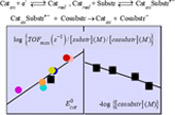Publication
865
J. Am. Chem. Soc. 140 (48), 16669-16675, 2018
DOI:10.1021/jacs.8b09154
|
|
|
|
|
|

|
Homogeneous Molecular Catalysis of Electrochemical Reactions: Manipulating Intrinsic and Operational Factors for Catalyst Improvement
|
|
|
|
Cyrille Costentin, and Jean-Michel Savéant
Université Paris Diderot, Sorbonne Paris Cité, Laboratoire d’Electrochimie Moléculaire, Unité Mixte de Recherche Université, CNRS 7591, 75205 Paris Cedex 13, France
Benchmarking and optimization of molecular catalysts for electrochemical reactions have become central issues in the efforts to match contemporary renewable energy challenges. In view of some confusion in the field, we precisely define the notions and parameters (potentials, overpotentials, turnover frequencies) involved in the accomplishment of these objectives and examine the correlations that may link them, thermodynamically and/or kinetically to each other (catalytic Tafel plots, scaling relationships, “iron laws”). To develop this tutorial section, we have picked as the model catalytic reaction scheme a moderately complex mechanism, general enough to illustrate the essential issues to be encountered and sufficiently simple to avoid the algebraic nightmare that a systematic study of all possible pathways would entail. The notion of scaling relations will be the object of particular attention, having notably in mind the delimitation of their domain of applicability. At this occasion, emphasis will be put on the necessity of clearly separating what is relevant to intrinsic characteristics (through standard quantities) to what deals with the effect of varying the reactant concentrations. It will be also stressed that the occurrence of such scaling relations, otherwise named “iron laws”, is not a general phenomenon but rather concerns families of catalysts. Likewise, the search of a general correlation between the maximal turnover frequency and the equilibrium free energy of the electrochemical reaction appears as irrelevant and misleading. This general analysis will then be illustrated by experimental data previously obtained with the O2-to-H2O conversion catalyzed by ironIII/II porphyrins in N,N'-dimethylformamide in the presence of Brönsted acids. |

